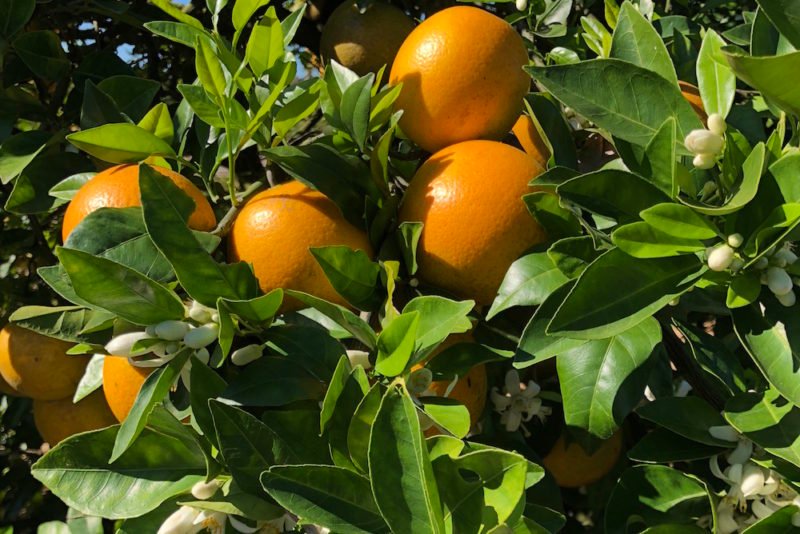
Last week I traveled to Florida, which was fabulous because I’m a bit sick of snow, but the real reason I was there was for the liquid sunshine, if you will. I spent an amazing few days with the Florida Department of Citrus and a great group of dietitians from around the country, literally learning about the process of making orange juice, from grove to glass. (Disclosure: my expenses for this trip were paid for.)
The Grove
Our first stop was, you guessed it, an orange grove. Primarily Valencia oranges, in this case. If you’ve never stood in the middle of an orange grove in bloom, I highly recommend. The scent of orange blossoms in the air is divine. What’s not divine are some of the struggles that Florida citrus growers (most of which are family farms) are going through. First there was citrus canker, which seemed like a very bad thing (it causes fruit and leaf drop and affects the appearance of the fruit, which makes it hard to sell). Then came citrus greening, which is worse.
Citrus greening is a disease transmitted by the Asian Citrus Psyllid, which first appeared in China roughly 100 years ago. The insect was spotted in Florida in 1998, and the disease was confirmed in 2005. This affects the vascular system of the tree, which means much of the nutrients absorbed by the root system can’t make it up the tree, and energy collected by the leaves during photosynthesis can’t make it down to the roots. A significant portion of the tree’s root system ends up dying, and over time the tree produces fewer, and smaller, fruits until it eventually dies. Orange and grapefruit trees are more susceptible, while lemon and lime trees are less affected.
Even though citrus growers from different regions and different countries—did you know that Brazil is the number 1 producer of juice oranges globally? And that Florida growers taught them how to do it!—are competing for market share, they are collaborating in the quest for a cure for this insect-born virus, sharing information and, at this point, home remedies. For example, one Florida citrus grower got the idea to feed his orange trees with the same fertilizer formula used to grow strawberries, and something about that specific blend of trace minerals helped his trees better withstand the damage from the virus. So now, citrus growers from all over are “spoon feeding” their trees with nutrients. They also use reflective mulch to bounce sunlight around and confuse the insects. Because baby trees have few natural defenses, they are covered with fine, insect-proof netting until they are about 3 years old and ready to bear fruit.
Farming is hard enough work, but fighting citrus greening has increased grower costs significantly—growers used to spend $800 per acre, now it’s more like $2,000 per acre—and some family farms aren’t surviving. Oh, and did I mention the havoc Hurricane Irma wrecked on Florida’s citrus groves in early 2018? Once upon a time, I had romantic notions of starting a hobby farm. Who the [bleep] was I kidding? Farming is hard, financially perilous work, and farmers (aka the people who grow our food) don’t get enough credit, or respect. (Stepping off my soapbox, now).

The Packing House
From the grove, we went to the packing house, where oranges and other citrus are received and sorted. Inferior fruit is destined to become cattle feed. The “prettiest” fruit goes for fresh eating. More than 90 percent of Florida oranges are processed for juice, because they are so well suited for it. In fact, Florida produces more than half of the orange juice in this country, and is the second largest producer in the world (after Brazil).
Fun fact: The green oranges and grapefruit are not underripe. A citrus fruit can be at the peak of ripeness, but just not developed the rind color you expect.
Farmers are very careful to harvest only ripe fruit, because it needs to have a certain balance of sugar and acid to meet the strict definition of what citrus and citrus juice is. If you’re talking about Florida orange juice, there’s a little more leeway, because juice from oranges that, say, are a little more on the acid side are blended with juice from oranges that are a little sweeter. But when you’re talking about fresh eating, be careful about jumping the gun on citrus season. For example, December is prime season for grapefruit, so grapefruit purchased earlier in the fall may be too tart for some people’s taste buds, because they were picked just as the fruit was becoming ripe enough (aka, early season). Citrus does not continue to ripen once it’s picked.
Nutrition in Florida orange juice
We’ve become a little…funny…about juice in this country. How did we get to the point were juice is being likened to soda? Really not a fair comparison! Now, if you were to drink juice all throughout the day whenever you were thirsty, that would be a bit much, from a calorie perspective and possibly from a carbohydrate perspective, depending on what other foods make up your typical diet.
Florida oranges are the country’s best juice oranges because of the climate, soil and rootstocks used to grow the trees. (The trees are not grown from seed, instead, a cutting of, say, a Valencia orange tree is grafted to roots from another type of orange tree that has desirable growing attributes. This process is also used with other types of fruit trees, even fruit trees you might buy at a garden center for your own backyard.)
Orange juice is definitely not sugar water. 100 percent orange juice has no added sugar and offers good nutrition in a one-ingredient package. An 8-ounce glass of orange juice is an excellent source of vitamin C (and calcium and vitamin D if you purchase fortified juice) and a good source of potassium, folate and thiamin. But wait, there’s more! There’s…hesperidin!
What the heck is hesperidin?
Hesperi-what? Hesperidin…the phytochemical you’ve never heard of, but you will. Phytochemicals (or phytonutrients, if you prefer) are natural compounds in plants that aren’t considered essential (yet) in the way that vitamins and minerals are, but research is uncovering just how important they are for human health. Let me put it this way: it’s likely that phytochemicals are a major reason that fruits and vegetables are so good for us.
Odds are you’ve heard of resveratrol, in red wine, and catechins, in green tea. Both are polyphenols, which is one class of phytochemical. Hesperidin is also a polyphenol, but drilling down even further, it’s also a flavonoid, which is a sub-category of polyphenols. Now that we’ve gotten the science-y part out of the way, what’s interesting about hesperidin, the most abundant flavonoid in orange juice, is that research studies have identified that can help reduce inflammation and also has benefits for heart and brain health. Even though it’s not officially classified as an antioxidant, like some phytochemicals, clinical studies have found that hesperidin has antioxidant properties (in other words, it behaves like an antioxidant).
What about juice and weight gain, or juice and blood sugar control? Well, studies have found no association between orange juice and weight gain or elevated blood sugar. Again, we’re talking about enjoying a glass with breakfast (or another meal), not drinking it all day. While hesperidin itself appears to promote a gradual rise in blood sugar—rather than a spike—the soluble fiber and pectin in orange juice may also help slow the absorption of its natural sugar.
Hesperidin is found in the pulp, juice and peel, but the greatest concentration is in the orange peel and membrane, so pressing oranges to make juice can increase how much hesperidin ends up in the juice. This is especially true for juice produced commercially, because they can press the oranges far more firmly than any home juicer could…trust me on this.
The Glass
On the second day of our tour, we got a rare (really!) look inside the Florida’s Natural processing facility. This is where whole citrus comes in, and citrus juice goes out. Unlike some orange juice producers, the Florida’s Natural cooperative grows all of the oranges right in Florida that go into their juice. We weren’t allowed to take any photos, partly to avoid capturing proprietary information, and partly for food safety reasons (we also had to wear hairnets, remove all jewelry and leave all belongings locked up). Pity, because the process is amazing. Not just the receiving, sorting, washing, squeezing, storing and packaging (bottling isn’t quite the right word, here!) of the juice, but all the other stuff that goes on.
With the aid of sophisticated computer systems, Florida’s Natural employees can monitor everything from temperatures to tank levels to any log-jams (orange-jams?) in the system. Everything is precisely controlled for both efficiency and safety. And…nothing is wasted. I mean, nothing. After the juice is squeezed, any remaining pulp is recovered, then the rind is “harvested” for citrus oils and essences that are used for both culinary and cosmetic purposes (think perfumes, soaps, lotions). Then, when those rinds have nothing else to give, they are turned into cattle feed. The facility also uses solar power, and recovers water that drips off the tanks from condensation and uses that to hose down the floors.
Oh, and about those tanks (well, specifically the storage tanks, because there are different tanks used for different purposes at various points of the process). Imagine standing in a room surrounded by four white tanks, each one 65 feet wide by 75 feet tall. It was like something out of science fiction…so cool! Oh, how I wish I had a photo (not that it would have captured the true magnitude). Instead, I’m going to share a photo from 10 years ago, when we were in Buenos Aires. I do think this is where my love of OJ truly began (let’s just say a childhood of “from concentrate” juice wasn’t overly inspiring).







